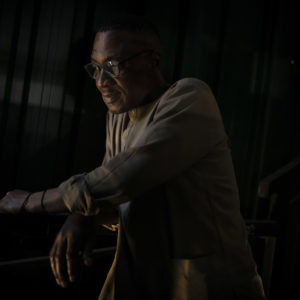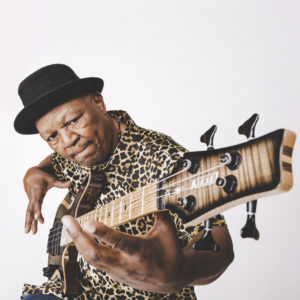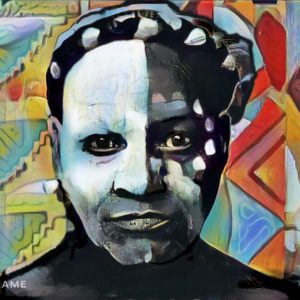It all comes together on McCoy Mrubata’s new album
The saxophonist has long dreamt of working with the community of musicians he’s built up over time. He has realised this dream on ‘First Green’, which he hopes to see performed at scale…
Author:
7 March 2022

It’s an unexpected opening for an album from McCoy Mrubata. Birdsong sounds before strings introduce a cyclical, almost folkloric melody. We’re nearly a minute in before Mrubata’s reed picks up the tune, soaring like one of those forest birds.
This is Mrubata’s The Strings Attached Project, performing Swedish vocalist Eva Rune’s composition First Green, the opening and title track of the saxophonist’s new album. For Mrubata, it’s the realisation of a long-cherished dream to work with the community of musicians he’s been building.
“I’ve been laying the foundations for this for some time,” says the saxophonist. “There was lots of pre-production work, for example getting string arrangements from my friend Gareth Harvey as far back as 2016. But it wasn’t until 2018 that Mvuzo Dimba, the pianist with Four Forty, hooked me up with string players from Daveyton in the East Rand. Wow, that’s a place that is so rich in talent.” Some tracks were laid down that year, at the same time as Mrubata’s Brasskap Sessions Volume III, on which “I always try to create some space for young community musicians”.
Related article:
Preparation also involved seeking arrangements from other longtime collaborators, such as vocalist and arranger Hlubi Kwebulana, and new partners, including bassists Concord Nkabinde and Viwe Mkizwana. “Viwe is a brilliant young man, who I first noticed from social media loved working with strings. I asked him if he did arrangements and then he said yes.” The album’s dozen tracks include Nkabinde’s new arrangement of Mrubata favourite Khumbul’Ekhaya, four tracks by Harvey and five by Mkizwana.
It’s a national project. Some tracks feature the string players from Daveyton and Soweto alongside Gauteng musicians with whom Mrubata often works. Others present collaborations with jazz musicians from Cape Town’s The Unity Band and a string quartet assembled in that city by Harvey.
All of this – the big team, the collaborative approach, the cross-national and cross-generational personnel – are deliberate steps in enacting Mrubata’s highly personal approach to social cohesion. He’s possibly one of few people who use the term without cynicism. For him, it’s not a slogan but a lived assertion that to achieve anything we have to be able to exist and work together.
Representing women
Music shouldn’t be a commodity owned by one individual, he says. “Working together takes my composing to another level. I can sketch a skeleton and send it to Hlubi, or Paul [Hanmer, pianist] or Jabu [Magubane, trombonist] or somebody else and they enhance it. Other musicians’ work always adds something to mine. Sometimes we can’t even explain exactly what that ‘something’ is – especially with Paul. But I make sure that copyright is shared so that we can all benefit from the work.
“That kind of working together has always been part of South African jazz history. But in the past, record companies didn’t do sleeve credits correctly and sometimes only the leader – or sometimes nobody – got what was due to them.”
The compositions on First Green reflect a similar sharing. “Eva’s a Swedish vocalist who worked with Paul on a project I wasn’t part of, but – you know I also do videography? – I helped film part of it. When she went home, she left a minidisc for me with Paul. She’d written a song for me – ‘It’s about spring in Sweden’ – and she hoped I liked it. Well, I loved it, but I couldn’t find a space for it then. So I shelved it until this project, where it was perfect. Then I contacted her and asked her to please take a photo of springtime trees, and that’s the cover art Hlubi incorporated into his sleeve design.”
Related article:
Even more personal is Shannon Mowday’s composition Women of Africa. Mowday is a South African reed player based in Scandinavia. “Shannon wrote the song in 2010 against gender-based violence and for my late daughter, who was murdered in Cape Town. She gave me the charts. Emotionally, I was knocked out. I knew it would fit on this album, but Shannon had created charts for big band. I asked Viwe to do string arrangement and I was really nervous, so I sent her a rough [version] to make sure she approved. And she loved it.” The result is the kind of number we often associate with Mrubata: sprightly and unmistakably South African in inflection, but with a haunting undercurrent of regret.
Gender equality matters to Mrubata, and one of the things he’s proudest of about First Green is the way it represents women not only as subject matter or voices – there’s a bonus digital track from Cape Town’s matriarch of jazz singers, Sylvia Mdunyelwa – but as composers and instrumentalists, too. “This album has been blessed by the ladies in every aspect,” Mrubata says.
Community training
The previously unheard compositions sit alongside familiar Mrubata compositions such as Two Ma Sophies, Tunisia (from Vivid Africa with Greg Georgiades) and Ma Madosini – sometimes sounding startlingly fresh in their new string clothes. But another thing that’s fresh is how the reedman plays.
“I definitely play differently,” he says. “Again, I have to thank my old friend Paul for helping me – on his albums Playola and Window To Elsewhere – to learn to play gentle, which was important in this music.
“Another thing I struggled with, as a lot of jazz players do, is that I play a bit behind the beat. That dragging or anticipating is deliberate, it’s the style of our music. But sometimes string players get frustrated – ‘Eh, man, this is jazz you’re playing now!’ – when their training is to come straight down on it. It’s tricky for classical musicians.”
Related article:
Mrubata noticed that the Joburg string players who’d had community as well as formal music training were more flexible. “They knew they must look not just at the charts but at the conductor and at me, too.” That’s one of the strengths, he says, of local music training in schools and community centres, whose current erosion he deplores. “When I was growing up in Langa, after I’d done homework and chores, my life rotated around the community centre. Badminton, boxing, art classes, a piano… though the queue for that was always too long and I never made it.”
Boxing actually helped him become a brass player. When his school started a marching band in 1973 and invited pupils to pick instruments, “it was a chaotic rush and I was so tiny, all that was left for me was the triangle. I was stuck with it for the whole year … But come 1974, I was tougher. I’d been doing amateur boxing, and then I got to the bugle.”
It wouldn’t take much investment, he says, to restore community centres to again become well equipped and the main feeders for music schools and universities. “These big projects and international showcases are great, but our culture must start in our communities, with grants to support making music.”For now, Mrubata is concentrating on promoting and building on this album. “Medium term, there’s a larger string ensemble in Tshwane, the Community Philharmonic Orchestra, I’d like to extend this music to.” And long term? “Maybe a symphony orchestra?”



